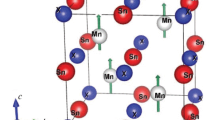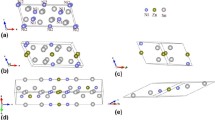Abstract
The structural, mechanical, thermodynamic and electronic properties of Pd-Sn compounds including PdSn4, PdSn3, PdSn2, PdSn, Pd2Sn and Pd3Sn have been investigated by first-principles calculation. Results show that all of the Pd-Sn compounds considered here are thermodynamically and mechanically stable, ductile, elastic anisotropic and have low micro-hardness. Among them, Pd2Sn is the most stable phase due to the lowest formation energy; PdSn exhibits the strongest anisotropy of the bulk modulus and shear modulus; Pd3Sn shows the isotropy of bulk modulus according to the percentage bulk modulus calculation. Debye temperature and minimum thermal conductivity have approximately the same variation trend with the percentage of Pd where Pd3Sn (or PdSn4) has the highest (or lowest) Debye temperature and minimum thermal conductivity. The electronic density of states shows a strong hybridization of Pd-d with Sn-p electrons near the Fermi level, which has an important impact on the reliability of crystal. The three-dimensional (3D) charge density difference map shows ionic properties for these compounds, and the ionicity increases with Pd concentration according to the Bader charge analysis.








Similar content being viewed by others
References
J. Kim, S.B. Jung, and J.W. Yoon, Effects of a phosphorous-containing Pd layer in a thin-ENEPIG surface finish on the interfacial reactions and mechanical strength of a Sn-58Bi solder joint. J. Alloys Compd. 820, 153396 (2020).
C.E. Ho, L.H. Hsu, C.H. Yang, T.C. Yeh, and P.T. Lee, Effect of Pd (P) thickness on the soldering reaction between Sn-3Ag-0.5 Cu alloy and ultrathin-Ni (P)-type Au/Pd (P)/Ni (P)/Cu metallization pad. Thin Solid Films 584, 257 (2015).
Y.W. Yen, P.H. Tsai, Y.K. Fang, S.C. Lo, Y.P. Hsieh, and C.I. Lee, Interfacial reactions on Pb-free solders with Au/Pd/Ni/Cu multilayer substrates. J. Alloys Compd. 503, 25 (2010).
J.W. Yoon, B.I. Noh, J.H. Yoon, H.B. Kang, and S.B. Jung, Sequential interfacial intermetallic compound formation of Cu6Sn5 and Ni3Sn4 between Sn-Ag-Cu solder and ENEPIG substrate during a reflow process. J. Alloys Compd. 509, 153 (2011).
K. Zeng, R. Stierman, D. Abbott, and M. Murtuza, The root cause of black pad failure of solder joints with electroless Ni/immersion gold plating. JOM 58, 75 (2006).
K. Suganuma and K.S. Kim, The root causes of the “black Pad” phenomenon and avoidance tactics. JOM 60, 61 (2008).
S.P. Peng, W.H. Wu, C.E. Ho, and Y.M. Huang, Comparative study between Sn37Pb and Sn3Ag0.5Cu soldering with Au/Pd/Ni (P) tri-layer structure. J. Alloys Compd. 493, 431 (2010).
Y.S. Wu, P.T. Lee, W.Z. Hsieh, T.T. Kuo, and C.E. Ho, Interfacial reaction and mechanical reliability between Sn-3Ag-0.5Cu alloy and ultrathin-Ni(P)-type Au/Pd(P)/Ni(P)/Cu metallization pad. Surf. Coat. Technol. 359, 374 (2019).
C.Y. Lee, S.P. Yang, C.H. Yang, M.K. Lu, T.T. Kuo, and C.E. Ho, Influence of Pd(P) thickness on the Pd-free solder reaction between eutectic Sn-Ag alloy and Au/Pd(P)/Ni(P)/Cu multilayer. Surf. Coat. Technol. 395, 1 (2020).
V. Simić and Z. Marinković, Room temperature interactions in Pd-metal thin film couples. Mater. Chem. Phys. 47, 246 (1997).
M.A. Rahman, C.E. Ho, W. Gierlotka, and J.C. Kuo, Experimental determination and thermodynamic modeling of the Sn-Rich corner of the ternary Ni-Pd-Sn phase diagram at 250℃. J. Electron. Mater. 43, 4582 (2014).
R. Hultgren, P.D. Desai, D.T. Hawkins, M. Gleiser, K.K. Kelley, and D.D. Wagman, Selected Values of the Thermodynamic Properties of the Elements (OH: American Society for Metals, 1973).
K.L. Shelton, P.A. Merewether, and J. Skinner, Phases and phase relations in the system palladium-platinum-tin. Can. Mineral. 19, 599 (1981).
I.R. Harris, M. Norman, and A.W. Bryant, A study of some palladium-indium, platinum-indium and platinum-tin alloys. J. Less Common. Met. 16, 427 (1968).
M.A. Kareva, E.G. Kabanova, G.P. Zhmurko, V.N. Kuznetsov, and A.V. Yatsenko, Phases of the NiAs family in Cu-Pd-Sn and Au-Pd-Sn systems. Russ. J. Inorg. Chem. 57, 502 (2012).
T.B. Massalski, Binary Alloy Phase Diagrams (OH: American Society for Metals, 1990), pp. 3049–3051.
Y.L. Tian, L.F. Zhang, and P. Wu, First-principles study of structural, elastic, and thermodynamic properties of PdSn4 with Ni addition. J. Electron. Mater. 49, 1435 (2020).
R. Kubiak and M. Wolcyrz, Refinement of the crystal structures of AuSn4 and PdSn4. J. Less Common Metals 97, 265 (1984).
K. Schubert, H.L. Lukas, H.G. Meissner, and S. Bhan, Pd5Sn7—A novel binary stannide in Pd-Sn system. Z. Metallkd. 50, 534 (1959).
J. Nylén, F.G. Garcıa, B.D. Mosel, R. Pöttgen, and U. Häussermann, Structural relationships, phase stability and bonding of compounds PdSnn (n= 2, 3, 4). Solid State Sci. 6, 147 (2004).
K. Schubert, H.L. Lukas, H.G. Meissner, and S. Bhan, Structure of the systems cobalt- gallium, palladium-gallium, palladium-tin, and related alloys. Z. Metallkd. 50, 534 (1959).
G. Kresse and J. Furthmüller, Efficient iterative schemes for ab initio total-energy calculations using a plane-wave basis set. Phys. Rev. B 54, 11169 (1996).
J.R. Guadagno and M.J. Pool, Liquid palladium-tin alloys. J. Phys. Chem. 72, 2535 (1968).
A.W. Bryant, W.G. Bugden, and J.N. Pratt, Calorimetric and galvanic cell studies of the thermodynamic properties of palladium-tin alloys. Acta Metall. 18, 101 (1970).
S.V. Meschel and O.J. Kleppa, Standard enthalpies of formation of some 3d, 4d and 5d transition-metal stannides by direct synthesis calorimetry. Thermochim. Acta 314, 205 (1998).
H.-J. Schaller and H. Brodowsky, Thermodynamic Properties of Pd-Sn Alloys. Z. Metallkd. 69, 87 (1978).
Y.F. Wu, B. Wu, and Z.Y. Wei, Structural, half-metallic and elastic properties of the half-Heusler compounds NiMnM (M = Sb, As and Si) and IrMnAs from first-principles calculations. Intermetallics 53, 26 (2014).
W. Zhou, L.J. Liu, B.L. Li, and P. Wu, Structural, elastic and electronic properties of intermetallics in the Pt-Sn system: a density functional investigation. Comput. Mater. Sci. 46, 921 (2009).
W.C. Hua, Y.A. Liu, D.J. Li, and H.L. Jin, Structural, anisotropic elastic and electronic properties of Sr-Zn binary system intermetallic compounds: a first-principles study. Comput. Mater. Sci. 99, 381 (2015).
J.L. Du, B. Wen, R. Melnik, and Y. Kawazoe, Phase stability, elastic and electronic properties of Cu-Zr binary system intermetallic compounds: a first-principles study. J. Alloys Compd. 588, 96 (2014).
H.-C. Cheng, C.-F. Yu, and W.-H. Chen, First-principles density functional calculation of mechanical, thermodynamic and electronic properties of CuIn and Cu2In crystals. J. Alloys Compd. 546, 286 (2013).
X. Zhang, C. Ying, Z. Li, and G. Shi, First-principles calculations of structural stability, elastic, dynamical and thermodynamic properties of SiGe, SiSn GeSn. Superlattices Microstruct. 52, 459 (2012).
C.M. Li, S.M. Zeng, and Z.Q. Chen, First-principles calculations of elastic and thermodynamic properties of the four main intermetallic phases in Al-Zn-Mg-Cu alloys. Comp. Mater. Sci. 93, 210 (2014).
M. Tao, Z.R. Wang, and C.X. Lan, Exploring phase stability, electronic and mechanical properties of Ce-Pb intermetallic compounds using first-principles calculations. J. Solid State Chem. 237, 385 (2016).
S.I. Ranganathan and M. Ostoja-Starzewskl, Universal elastic anisotropy index. Phys. Rev. Lett. 101, 055504 (2008).
J.Y. Wu, B. Zhang, and Y.Z. Zhan, Ab initio investigation into the structure and properties of Ir-Zr intermetallics for high-temperature structural applications. Comput. Mater. Sci. 131, 146 (2017).
Y. Liu, X. Chong, Y. Jiang, R. Zhou, and J. Peng, Mechanical properties and electronic structures of Fe-Al intermetallic. Phys. B Condens. Matter 506, 1 (2017).
D.R. Clarke and C.G. Levi, Materials design for the next generation thermal barrier coatings. Annu. Rev. Mater. Res. 33, 383 (2003).
D.G. Cahill, S.K. Watson, and R.O. Pohl, Lower limit to the thermal conductivity of disordered crystals. Phys. Rev. B 46, 6131 (1992).
Y.H. Duan, Y. Sun, and L. Lu, Thermodynamic properties and thermal conductivities of TiAl3-type intermetallics in Al-Pt-Ti system. Comput. Mater. Sci. 68, 229 (2013).
H.C. Deng, Theoretical prediction of the structural, electronic, mechanical and thermodynamic properties of the binary α-As2Te3 and β-As2Te3. J. Alloys Compd. 656, 695 (2016).
R.F.W. Bader, Atoms in Molecules: A Quantum Theory (New York: Oxford University Press, 1990).
G. Henkelman, A. Arnaldsson, and H. Jonsson, A fast and robust algorithm for Bader decomposition of charge density. Comput. Mater. Sci. 36, 254 (2006).
Acknowledgments
This work was supported by the National Natural Science Foundation of China (51572190), and the super computing resources were supplied by the High Performance Computing Center of Tianjin University, China.
Author information
Authors and Affiliations
Corresponding author
Ethics declarations
Conflict of interest
The authors declare that they have no conflict of interest.
Additional information
Publisher's Note
Springer Nature remains neutral with regard to jurisdictional claims in published maps and institutional affiliations.
Rights and permissions
Springer Nature or its licensor (e.g. a society or other partner) holds exclusive rights to this article under a publishing agreement with the author(s) or other rightsholder(s); author self-archiving of the accepted manuscript version of this article is solely governed by the terms of such publishing agreement and applicable law.
About this article
Cite this article
Tian, Y., Jia, G. & Wu, P. First-Principles Study on the Structural, Elastic and Thermodynamic Properties of Binary Pd-Sn Compounds. J. Electron. Mater. 52, 1875–1887 (2023). https://doi.org/10.1007/s11664-022-10089-9
Received:
Accepted:
Published:
Issue Date:
DOI: https://doi.org/10.1007/s11664-022-10089-9




